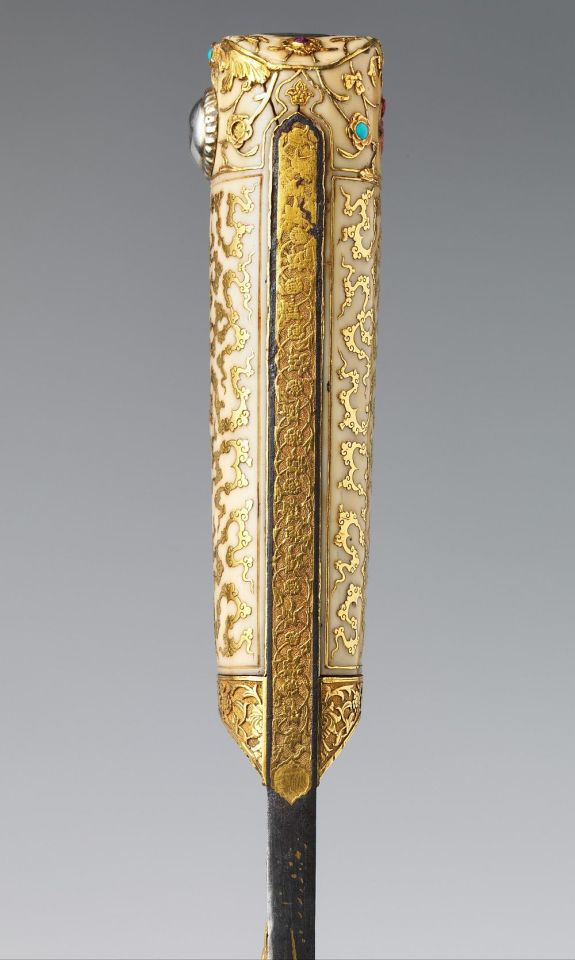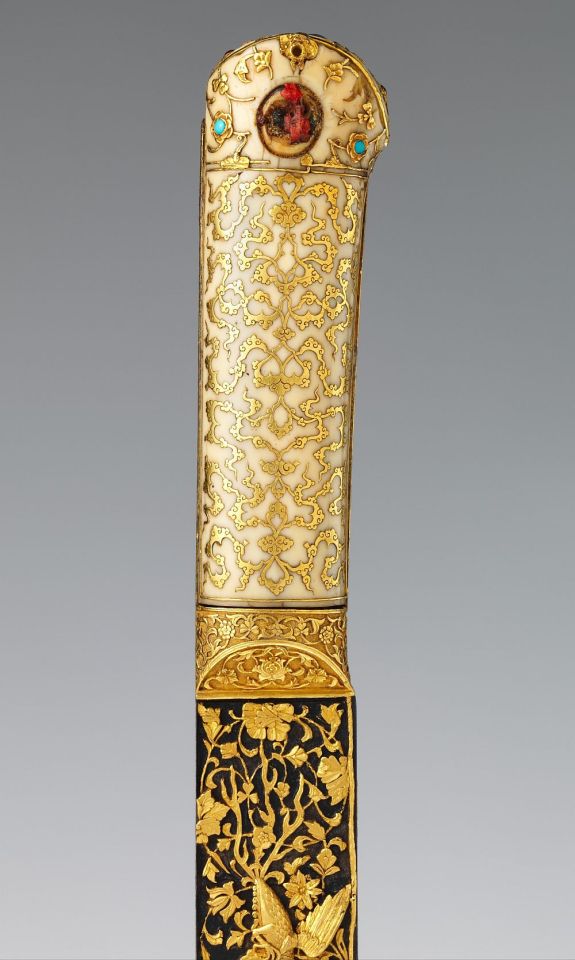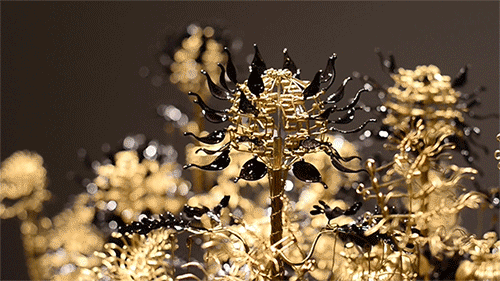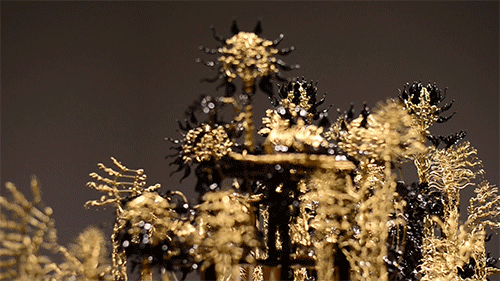Naturally Etched Garnet That Looks Like A Crazy Cool City Photographed By Enrico Bonacina Found Via @dusted77

Naturally etched Garnet that looks like a crazy cool city photographed by Enrico Bonacina found via @dusted77 ////////
www.mindat.org/gallery-13835.html
www.instagram.com/dusted77
www.mineraliety.com
More Posts from Othermanymore and Others




Early Medieval pattern-welded Sickle
Reconstruction by Thorkil
The sickle was based on an antler sickle case found in Stargard Szczecinski, West Pomerania (Poland). The original was richly decorated with geometrical motives, popular at that time. Thorkil’s version is a very faithful reconstruction of it, with all circles, dots, triangles and lines made on natural deer antler.
The decoration was hand engraved, then coloured with natural dark dye for a contrast and stronger effect. The sickle blade’s is pattern-welded (damascus) steel. It was hand forged (in charcoal fire) of 20 twisted layers. The cutting edge was forge-welded to pattern-welded part.
Source: Copyright © 2017 Thorkil










Yatagan Sword from the Court of Süleyman the Magnificent (reigned 1520–66)
Dated: circa 1525–30
Sword maker: Workshop of Ahmed Tekelü (possibly Iranian, active Istanbul, ca. 1520–30)
Geography: Istanbul
Culture: Ottoman, Istanbul
Medium: steel, gold, ivory (walrus), silver, turquoise, pearls, rubies
Measurements: overall length 23 3/8 inches (59.3 cm); blade length 18 3/8 inches (46.7 cm); weight 1 lb. 8 oz. (691 g)
Exquisite workmanship and lavish use of precious materials distinguish this sword as a princely weapon and exemplifies the opulence and refinement of Ottoman luxury arts. Almost identical to a yatagan (now in the Topkapi Palace, Istanbul) made in 1526–27 by the court jeweller Ahmed Tekel, for the Ottoman sultan Süleyman the Magnificent (r. 1520–66), this sword was undoubtedly made in the same imperial workshop.
The gold incrustation on the blade depicts a combat between a dragon and a phoenix against a background of foliage scrolls. These figures, like the gold-inlaid cloud bands and foliage scrolls on the ivory grips, are Chinese in inspiration, and were probably introduced into Ottoman art through contacts with Persia.
This sword is one of the earliest known yatagans, distinctly Turkish weapons characterised by a double-curved blade and a hilt without a guard. Yatagans were commonplace in Turkey and the Balkans in the eighteenth and nineteenth centuries and served as sidearms for the elite troops known as Janissaries.
Source: Copyright © 2016 Metropolitan Museum of Art
-
 surfingthesealand liked this · 1 year ago
surfingthesealand liked this · 1 year ago -
 cluelessyasmin reblogged this · 1 year ago
cluelessyasmin reblogged this · 1 year ago -
 cluelessyasmin liked this · 1 year ago
cluelessyasmin liked this · 1 year ago -
 rubyleaf liked this · 1 year ago
rubyleaf liked this · 1 year ago -
 spinef0ryou reblogged this · 1 year ago
spinef0ryou reblogged this · 1 year ago -
 jugos1 reblogged this · 2 years ago
jugos1 reblogged this · 2 years ago -
 owlspirit liked this · 3 years ago
owlspirit liked this · 3 years ago -
 glowpasdansledark liked this · 3 years ago
glowpasdansledark liked this · 3 years ago -
 mimeticspace reblogged this · 3 years ago
mimeticspace reblogged this · 3 years ago -
 whimsical-cloud reblogged this · 3 years ago
whimsical-cloud reblogged this · 3 years ago -
 super-momo-fan liked this · 3 years ago
super-momo-fan liked this · 3 years ago -
 tsundoku78 reblogged this · 3 years ago
tsundoku78 reblogged this · 3 years ago -
 tsundoku78 liked this · 3 years ago
tsundoku78 liked this · 3 years ago -
 serene-disarray reblogged this · 3 years ago
serene-disarray reblogged this · 3 years ago -
 serene-disarray liked this · 3 years ago
serene-disarray liked this · 3 years ago -
 thewanderingslowpoke reblogged this · 3 years ago
thewanderingslowpoke reblogged this · 3 years ago -
 thewanderingslowpoke liked this · 3 years ago
thewanderingslowpoke liked this · 3 years ago -
 laverapantera reblogged this · 4 years ago
laverapantera reblogged this · 4 years ago -
 laverapantera liked this · 4 years ago
laverapantera liked this · 4 years ago -
 therocksinmypockets reblogged this · 4 years ago
therocksinmypockets reblogged this · 4 years ago -
 onekindredspirit liked this · 5 years ago
onekindredspirit liked this · 5 years ago -
 ismail-isak liked this · 5 years ago
ismail-isak liked this · 5 years ago -
 amour8infini reblogged this · 5 years ago
amour8infini reblogged this · 5 years ago -
 its-hercollectionkoala reblogged this · 5 years ago
its-hercollectionkoala reblogged this · 5 years ago -
 its-hercollectionkoala liked this · 5 years ago
its-hercollectionkoala liked this · 5 years ago -
 glacialdrip reblogged this · 5 years ago
glacialdrip reblogged this · 5 years ago -
 stanfave3-72217 reblogged this · 5 years ago
stanfave3-72217 reblogged this · 5 years ago -
 ssolson liked this · 5 years ago
ssolson liked this · 5 years ago -
 steviedegrae liked this · 5 years ago
steviedegrae liked this · 5 years ago -
 whvtapunk reblogged this · 5 years ago
whvtapunk reblogged this · 5 years ago -
 whvtapunk liked this · 5 years ago
whvtapunk liked this · 5 years ago -
 3eyeswidenlooking reblogged this · 5 years ago
3eyeswidenlooking reblogged this · 5 years ago -
 3eyeswidenlooking liked this · 5 years ago
3eyeswidenlooking liked this · 5 years ago -
 libertyroad reblogged this · 5 years ago
libertyroad reblogged this · 5 years ago -
 niftyandinterestingstuff reblogged this · 5 years ago
niftyandinterestingstuff reblogged this · 5 years ago -
 niftyandinterestingstuff liked this · 5 years ago
niftyandinterestingstuff liked this · 5 years ago -
 davidwaynealdrich-blog liked this · 5 years ago
davidwaynealdrich-blog liked this · 5 years ago -
 fatbelladonna105 liked this · 5 years ago
fatbelladonna105 liked this · 5 years ago -
 patterncrystal reblogged this · 6 years ago
patterncrystal reblogged this · 6 years ago


















